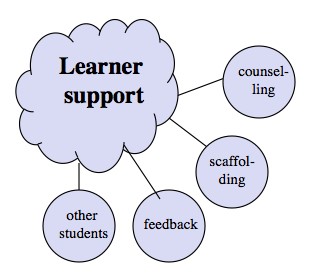Lesson 6 - Learner Support
| Site: | Technology-Enabled Learning Lounge |
| Course: | Teaching in a Digital Age |
| Book: | Lesson 6 - Learner Support |
| Printed by: | Guest user |
| Date: | Wednesday, 24 December 2025, 10:47 AM |
1. Watch this Video on Learner Support
2. Learner Support

2.1. Learner Support Within a Learning Environment
Learner support focuses on forms of
assistance to learners beyond the delivery of content, skills development,
or formal assessment.
Brindley et al. (2004) provide an extensive overview of the full range of activities in providing learner support for online and distance education learners. Here though my focus is limited to indicating why it is an essential element of an effective learning environment, and to describe briefly some of the main sub-components of learner support.
2.2. Scaffolding

I use the term scaffolding to cover the many functions in diagnosing and responding to learners’ difficulties, including:
- Helping students when they struggle with new concepts or ideas.
- Helping students to gain a deeper understanding of a topic or subject.
- Helping students to evaluate a range of different ideas or practices.
- Helping students to understand the limits of knowledge.
- Above all challenging students to go beyond their current level of thinking or practice to acquire deeper understanding or a higher level of competency.
These activities normally take the form of personal interventions and communication between an instructor and an individual or a group of students, in face-to-face contexts or online. These activities tend not to be pre-planned, requiring a good deal of spontaneity and responsiveness on the part of the teacher or instructor.
However, more recently there have been examples of automated learner support, such as virtual assistants or chatbots (for a review of research on chatbots in education, see Winkler and Söllner, 2018). Also learning analytics have been used to determine a student’s performance and where necessary to direct them to further readings or work (see for instance, Vesin et al., 2018).
Scaffolding is usually a means of individualizing the learning, enabling student differences in learning to be better accommodated as they occur.
2.3. Feedback
This could be seen as a sub-category of scaffolding, but it covers the role of providing feedback on student performance of activities such as writing assignments, project work, creative activities, and other student activities beyond the current and perhaps future scope of automated computer feedback. Again, the instructor’s role here is to provide more individualization of feedback to deal with more qualitatively assessed student activities and may or may not be associated with formal assessment or grading.
2.4. Counselling
As well as direct support within their academic studying, learners often need help and guidance on administrative or personal issues, such as financial difficulties, or whether to repeat a course, delay an assignment because of sickness in the family or cancel enrolment in a course and postpone it to another date. Although such services maybe available outside the provision of a particular course, this potential source of help needs to be considered in the design of an effective learning environment, with the aim of doing all that can be done to ensure that students can manage external pressures while meeting the academic standards of a program.
2.5. Why Learner Support is so Important
We shall see that good design can substantially reduce demand for learner support, by ensuring clarity and by building in appropriate learning activities. Students also vary enormously in their need for support in learning. Many lifelong learners, who have already been through post-secondary education, have families, careers and a great deal of life experience, can be self-managed, autonomous learners, identifying what they need to learn and how best to do this. At the other extreme, there are students for whom the formal school system was a disaster, who lack basic learning skills or foundations, such as reading, writing and mathematical skills, and therefore lack confidence in learning. These will need a lot of support to succeed.
However, the vast majority of learners are somewhere in the middle of the spectrum, occasionally running into problems, unsure what standards are expected, and needing to know how they are doing in their studying. Indeed, there is a good deal of research that indicates that ‘instructor presence’ is associated with student success or failure in a course, at least in online learning (see, for instance, Shea et al., 2010). Where students feel the instructor is not present, both learner performance and completion rates decline. For such students, good, timely learner support is the difference between success and failure.
It should be noted that the need for good learner support, and the ability to provide it, is not dependent on the medium of instruction. The kind of credit online courses that have been designed and delivered long before MOOCs came along often provided high levels of learner support, through having a strong instructor presence and careful design to ensure students were supported.
At the same time, although computer programs can go some way to providing learner support, many of the most important functions of learner support associated with high-level conceptual learning and skills development still need to be provided by an expert teacher or instructor, whether present or at a distance. Furthermore, this kind of learner support is difficult to scale up, as it tends to be relatively labor-intensive and requires instructors with a deep level of knowledge within the subject area. Thus, the need to provide adequate levels of learner support cannot just be wished away if we are to achieve successfully learning on a large scale.
This may seem obvious to teachers, but the importance of learner support for student success is not always recognized or appreciated, as can be seen from the design of many MOOCs, and the reaction of politicians and the media to the cost savings promised by the kind of MOOCs that focus on eliminating learner support. There are also different attitudes from instructors and institutions towards the need for learner support. Some faculty may believe that ‘It’s my job to instruct and yours to learn’; in other words, once students are presented with the necessary content through lectures or reading, the rest is up to them.
Nevertheless, the reality is that in any system with a wide diversity of students, as is so common today, effective learner support is essential for student success.
2.6. Activity (Reflective Thinking, Note Taking and Discussion)
This activity is optional. It is presented to facilitate your reflective thinking on the issues. There are no feedback. We encourage you to discuss these with your colleague.
Building learner support
- Do you think it is possible to design an effective course or program without the need for high levels of learner support? If so, what would it look like?
- How can you integrate learner support in your course?
- What are the learner support in this course?
3. Key Takeaways
 |
Key takeaways from this lesson are:
|
|---|